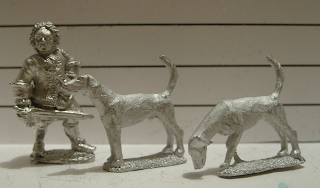 |
| "It slimed me Ray" - Pour on the gloop. |
Now we come to the first truly messy bit! I would advise those of you with live-in womenfolk to buy a few things in advance or alternatively make sure they are out enjoying themselves at H&M/Gap etc when you start to play with their kitchen equipment.
You will need a funnel, a large shallow dish or pan (the type used for roasting meat is great), a kitchen jug, a cheap brush (I use ASDA/WalMart pastry brushes 29p a time), an empty plastic pop bottle - 2 litre or above, a whisk or hand blender, a cookie cooling rack, an old carrier bag and preferably a turkey baster.
Firstly mix PVA glue (This time the kiddie stuff is fine - but woodworking is still better) and water into a smooth single-cream like consistency - important that this is not too thick. You should make every effort to avoid any lumps - they cause minor problems later. Old PVA glue will have these in abundance. Mine had a few - annoying as this was to be a tutorial! Just take it as a "what not to do"! Once you have a smooth creamy gloop decant it into the pop bottle (hence the funnel)
 |
| Brush the emulsion into the oasis. |
Now pour a little of the gloop into the bottom of the shallow dish and place your building on top of the liquid. The oasis (being the absorbent "wet" type) will begin to slurp up the liquid. If you made your emulsion too thick this will not happen and you will have an island floating on a sea of white. Once it is absorbed start pouring the gloop all over the building, concentrating on natural reservoirs in the structure.
The oasis will suck up copious quantities so don't be mean with your glue mix. When the structure is drenched start brushing the collected gloop onto the structure concentrating on apertures and recesses. This is why the turkey baster is so useful, you can shoot jets just where you want them. My turkey baster had perished so I had to use only the brush. If you are unlucky enough to have lumps gently brush them away - or in severe cases - pick them off. Be especially vigilant of lumps in door/window areas as this is where they congregate.
 |
| Dipping each facet speeds absorption. |
The aim is to completely saturate the oasis with gloop. You can see when this is effected as it begins to repel the emulsion and oozes glue if gently prodded. The absorption can be achieved more speedily if the structure is rotated whilst "basting" with each facet taking it's turn in the sea of glue. Another way to accelerate this stage is to cut large "wells" in the building's underside. This reduces the density of the oasis and allows the glue to enter "from the inside" as it were.
Now prepare your drying/cooling rack. Wrap it up in a plastic carrier bag - securing the plastic with tape. The bag is there to ensure the model does not stick to the rack when drying - it can happen and is very demoralising when it does. Make sure the bag is sufficiently loose that you can create little recesses to collect the run-off during drying. Now gently lift you magnum opus and place onto the rack. Make sure all important areas are adequately supported as the oasis will now be quite heavy and any delicate parts will be liable to fracture under their own weight. To give you some idea of this medium's absorbency, this little building drank close to 1.5 litres of gloop.
 |
| On the rack waiting to dry. |
Unless you live in a warm area, you will need to use an airing-cupboard or similar to dry the building. Do not attempt to accelerate the process in an oven as this will cause the whole thing to become brittle, fracture or indeed melt! Depending upon the size of the building drying time can take anything up to about a week. I expect this one to be ready in that sort of time frame.
The end result will be a very durable but lightweight version of your original. It will be firmly glued together and ready for the next stage.
In the meantime you can make the other structures in your complex and get to work on window frames and/or doors ready for insertion when the structure is dry.























